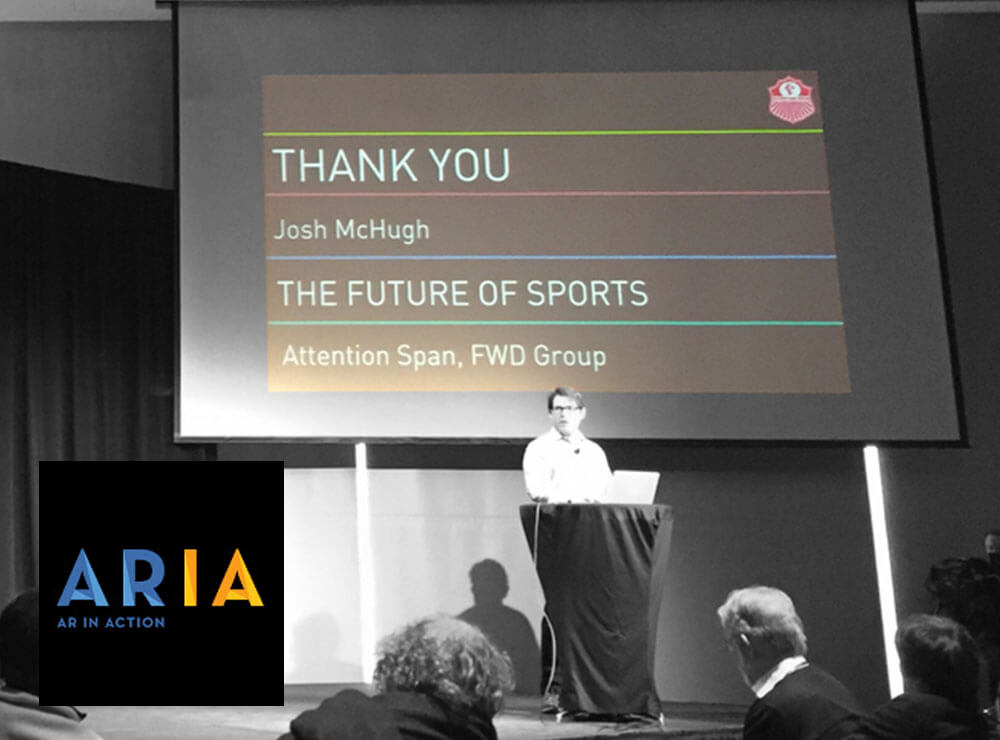Attention Span @ MIT Media Lab

The Future of Augmented Reality in Sports
Several generations of pioneers in the fields of human-computer interaction, media arts, and game technology gathered for the AR in Action conference at the MIT Media Lab in Cambridge last month. They came to share recent advances in augmented reality, see presentations on the current state of the art and hear how new AR developments on the horizon are poised to change the way humanity communicates and moves through the world.
I was honored to share the stage with these titans, to deliver a presentation on the future of AR in sports, using the most recent edition of The Future of Sports as a starting point.
Making Time Machines
Robert Metcalfe (of Metcalfe’s Law) took the stage on the first day of the conference. After noting that Pattie Maes, Robert Scoble and Daniel Kraft were tough acts to follow, Metcalfe got right to the point: “The single most important new fact about the human condition is that we are connected.”
Likening the current era of augmented reality development to his days at Xerox PARC, where he invented the Ethernet protocol (“so we wouldn’t have to carry our floppy disks over to the printer”) Metcalfe said that he and his PARC colleagues were essentially “building time machines” – inventions that allow users to project themselves into the future and experience capabilities that will be possible when current technical limitations (i.e. bandwidth, materials costs, etc.) no longer stand in the way. The first killer app for AR, Metcalfe said, will be just such a time machine.
We think sports could be where that AR time machine appears first.
Distant Holograms
During our research for the first edition of The Future of Sports in 2015, we did some heavy research and scenario-building around hologram technology. One inspiration: a video created by Japan’s World Cup committee, proposing an in-stadium holographic system that would simulcast projected versions of live soccer games in stadiums, with life-size holographic players occupying real space on real fields.
The main obstacle between that vision and reality: engineering a projection substrate that can cover a playing field and render holograms in high enough resolution for the fans in the cheap seats to have a good time. In many cases during our research for Future Of Sports 1.0, the timeline estimates for our scenarios began at 20 or 10 years; then, as we talked to innovators in the fields propelling our scenarios forward, we ended up shortening those timelines drastically, down to 10 years, or 5, or even discovering that early forms of the things we were predicting already existed. However, full-field holographic sports events stubbornly remained in the 10-to-15 year distance.
The Future is Already Here, Again
Last year, early in the course of our reporting for Future of Sports 2.0, we visited Jody Medich, a virtual and augmented reality researcher with Singularity University, in her office at NASA Ames Research Center. She made a strong case that, since AR keeps the user in the real world, applications for AR would quickly overtake those for VR. As we dug into AR, testing prototypes of Microsoft’s HoloLens and Meta’s high-definition, large field-of-view Meta 2 system, we realized that the age of sports holograms is already here (just not evenly distributed yet): In the very near future, AR displays will enable us to collectively experience sporting events in real-world social gatherings as envisioned in the projection-hologram scenarios – first for small groups gathered around a shared virtual space, eventually for stadium-sized crowds.
Even more exciting, we saw that the next generation of AR display technology will make the following tools possible:
1. Player headgear that provides real-time guidance by highlighting key players and specific game actions via visual overlays while minimizing distractions via “diminished reality,” highlighted by Neil Gupta in his presentation earlier in the conference.
2. Coaches’ headgear that provides recommendations between plays, informed by machine-learning analysis of the opposing coach’s entire history in similar game situations.
In these cases, the AR time machines will provide their users – coaches and players – with a look into the crucial seconds and fractions of a second directly ahead.
As gaming pioneer Bing Gordon pointed out later in the conference, the mechanics and usage patterns of AR in sports have been in use for years, thanks to Madden, FIFA, NBA 2K and other sports titles, which have incorporated assistive graphic overlays for players since their earliest versions.
The bigger question is how leagues will react to these time machines. Even though the NFL seems the natural choice as the first stop for player/coach AR, remember that in-helmet radios were invented and used by the Cleveland Browns in 1956 – and promptly banned by the league until 1994. Teams will start by experimenting with AR as a training tool. Steph Curry and other NBA players already use diminished reality to enhance their ball-handling and shooting accuracy by training with strobe goggles.
During the presentation, the following slide accompanied the robo-coach scenario, drawing laughs from attendees – almost certainly more due to my awkwardly-pasted-together HoloLens image than to the terrifying prospect of an AI-enhanced Bill Belichick.
